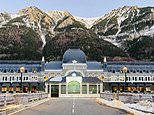
Once it was called The Titanic of the Mountains — a grandiose, lavish building which was the second largest railway station in Europe (Leipzig was the biggest).
Canfranc International station, more than 3,280ft above sea level, opened in 1928 — an outlandishly ambitious project which linked the French and Spanish Pyrenees with a five-mile cross-border tunnel.
But even its famed grandeur — it is ten times bigger than St Pancras, has 365 windows and a 790ft platform — failed to save it from the ravages of a disastrous fire, the Spanish Civil War, World War II, and the issue of French and Spanish railway gauges being of different widths, which meant all freight and passengers had to change trains at the station.
It finally closed permanently in 1970, following a freight train derailment. But Canfranc International, with its tales of smuggled Nazi gold, stood firm even when it was unoccupied.
Now, after a multi-million-pound injection of capital from the EU, the Aragon Government and Barcelo Hotel Group, it has been reborn as the Canfranc Estacion, a five-star Royal Hideaway Hotel with 104 rooms, a wellness spa and a convention centre. It has taken the best part of five years to restore its glorious Beaux-Arts architecture and marry it to the demands of the 21st century.
Historic: Jo Knowsley checks into the Canfranc Estacion, a five-star hotel in north-eastern Spain that was formerly the second largest railway station in Europe. Above is the station before its refurbishment
The five-star Royal Hideaway Hotel features 104 rooms, a wellness spa and a convention centre. The image above shows the property post-refurb
I am the first British journalist to check in and although some duplex suites are still unavailable — and the railway dining car, decked out rather like those on the Orient Express, is still stuck in Zaragoza, 96 miles away, because of heavy snowfall — it’s mighty impressive.
There’s a buzz in the lobby, once the lofty customs hall, with the coat of arms of France high on one wall and that of Spain on the wall above reception.
The general public are invited to visit and many have come in out of the snow.
The rooms, spa, swimming pool, bar, restaurants and Library cocktail bar are all hidden away behind mirrored doors at each end of the lobby.
‘Welcome, welcome,’ says Juan, the deputy manager on reception, who is dressed in the same green and cream uniform (complete with a whistle on his sleeve) that workers wore in the 1930s at the original Canfranc International station.
The lobby is crowded with sight-seers, some still in ski gear, having come from the nearby Candanchu Ski Resort, a mere three miles away and a spit from the French border.
‘I hope you don’t mind all these people,’ says Juan.
Not in the slightest, but a fellow guest wandering across for a spa treatment, in his bathrobe, looks rather bemused.
Jo notes that the lobby is crowded with sight-seers, some still in ski gear, having come from the nearby Candanchu Ski Resort (above), which lies a mere three miles away
Jo finds that there’s a buzz in the lobby, once the lofty customs hall
The rooms, spa, swimming pool, bar, restaurants (above) and Library cocktail bar are all hidden away behind mirrored doors at each end of the lobby
Friendly Juan tells us how some of the staff played in the old station as children and that ‘for them it’s like being part of a living museum’.
Then he shows us the marble staircase which leads down and under the lobby, out to the forecourt.
It was designed to protect wealthy travellers from having to encounter hoi polloi.
Our junior suite — also dressed in the station’s traditional colours of cream and sage green, with oak parquet floors — costs €335 B&B, for which we get unobscured views of the snow-clad mountains.
It has taken the best part of five years to restore the station’s glorious Beaux-Arts architecture and marry it to the demands of the 21st century as a hotel
Jo enjoys impeccable service and terrific cocktails at the hotel’s restaurant (above)
The train station was once called The Titanic of the Mountains, Jo reveals
The picture above shows the hotel’s swanky pool area
For train buffs, there is an assortment of rail memorabilia at the hotel
Jo says that if you’re holidaying in the Pyrenees, ‘it would be a tragedy to give this extraordinary slice of history a miss’
On one wall there is an historic picture of the station, framed in an original window.
Canfranc is in a narrow valley, surrounded by mountains.
The town itself (population 500) is diminutive, although it is on the route of the Camino de Santiago pilgrimage trail.
The restaurant we choose for dinner (there will be three of them, eventually) is excellent, with impeccable service and terrific cocktails — all at a price similar to what you’d expect to pay in a British gastropub.
Outside, behind the hotel, a new station has been built for passenger trains to Zaragoza. And for train buffs there is an assortment of rail memorabilia.
There’s only one glitch (and a little ironic perhaps) for we Britons.
For a former railway station that once linked two countries, getting to Canfranc Estacion is not easy.
It’s a two-hour train journey from the airport at Zaragoza, or four to six hours from Barcelona.
If you’re holidaying in the Pyrenees, however, it would be a tragedy to give this extraordinary slice of history a miss.
TRAVEL FACTS
Double rooms at Canfranc (barcelo.com) from £133 a night. Ryanair (ryanair.com) flies to Zaragoza from £16.99 one-way.
Source link
CHECK OUT: Top Travel Destinations
READ MORE: Travel News



